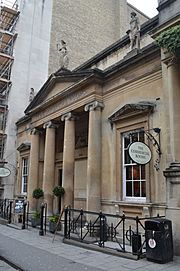Commercial Rooms, Bristol facts for kids
Quick facts for kids Commercial Rooms |
|
|---|---|
 |
|
| General information | |
| Town or city | Bristol |
| Country | England |
| Coordinates | 51°27′16″N 2°35′40″W / 51.4545°N 2.5945°W |
| Completed | 1810 |
| Design and construction | |
| Architect | Charles Busby |
The Commercial Rooms (grid reference ST587729) are a historic building located on Corn Street in Bristol, England.
This important building was finished in 1810 by an architect named Charles Busby. It features cool sculptures by J. G. Bubb. Originally, it was a special club for merchants and business people. They even had a wind vane above the bar! This helped merchants know if it was safe for their ships to travel through the tricky Avon Gorge. The walls still show the names of all the club's past leaders. Today, the Commercial Rooms is a pub owned by Wetherspoons.
A Look Back in Time
Before the Commercial Rooms, business people in Bristol met at a place called the Tolzey, built in 1614. Later, The Exchange was built in 1743 for all kinds of businesses. But once the Commercial Rooms opened in 1808, The Exchange became mainly for the corn trade.
The very first president of the Commercial Rooms in 1808 was John Loudon McAdam. He was famous for inventing tarmac, which is used to make roads!
In 1852, the first telegraph office in Bristol was set up right here. A telegraph line went out to Shirehampton. This meant messengers didn't have to ride horses into the city anymore to announce ships arriving in the Bristol Channel.
During the Second World War, Bristol was bombed. The Commercial Rooms needed a lot of repair work because of the damage. They even had to rebuild the head of one of the statues on the roof!
By 1951, the main room had a "tape machine." This machine would show stock market information. In the summer, it also broadcast cricket scores, which was a fun way to keep up with the games!
The Commercial Rooms is a very important building. English Heritage has given it a special Grade II* listed building status. This means it's a building of more than special interest and is protected.
Cool Features and Design
The front entrance of the building has a grand porch called a portico. It's built in the ancient Greek style, known as the Ionic order. Above the columns, there are three statues. They represent the City of Bristol, Commerce (business), and Navigation (sailing).
Even higher up, there's a detailed carving called a relief. It shows Britannia (a symbol of Britain), Minerva (the Roman goddess of wisdom), and Neptune (the Roman god of the sea). They are shown receiving gifts from the earth.

